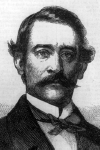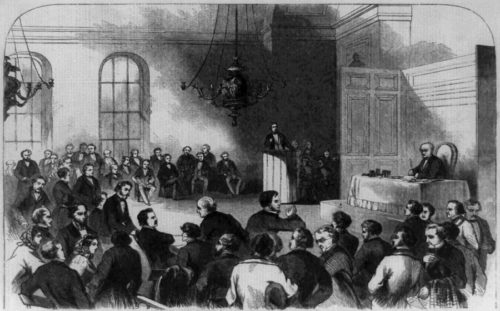 Over the last two weeks, we have looked at the death of John R Nally, and the trial of Daniel W. Jarboe for his killing. While the trial itself was quite short, the final speeches of the various attorneys – including a 1-1/2 hour stemwinder by Jarboe’s attorney Joseph H. Bradley – consumed most of the afternoon of that third day of the trial. It was thus just before dinner time that the case was turned over to the jury. The Evening Star of July 30, 1856, gives the surprising denouement:
Over the last two weeks, we have looked at the death of John R Nally, and the trial of Daniel W. Jarboe for his killing. While the trial itself was quite short, the final speeches of the various attorneys – including a 1-1/2 hour stemwinder by Jarboe’s attorney Joseph H. Bradley – consumed most of the afternoon of that third day of the trial. It was thus just before dinner time that the case was turned over to the jury. The Evening Star of July 30, 1856, gives the surprising denouement:
The jury, by permission of the Court, retired to dinner, and upon their return, soon after six o’clock, they returned a verdict of acquittal. [emphasis in the original]
The jury had agreed with Bradley’s assessment that Jarboe had indeed been “unhinged at the time of the transaction” and that he was thus not guilty of murder. The Star then ends the story:
Upon the rendition of the verdict a most affecting interview took oplace between the prisoner and his aged father, and the couple (father and son) emerging soon after from the court room, bent their way homewards, accompanied by numbers of friends.
Jarboe’s further career was not marked with particular success. While he joined the D.C. police force, he was dismissed in August 1871 for “gross violation of the rules.” Eventually, he moved to Topeka, Kansas, and worked in the yards of the Atchison, Topeka & Santa Fe Railway. He lived close to the yards. He died in 1913. Where his house once stood is today a substation of the Topeka Police Department.
Much more interesting is the later history of the defense offered by Bradley. When Representative Daniel Sickles was put on trial in 1859 for the murder of his wife’s paramour, it was Jarboe’s case that was frequently cited by the defense. In a trial that lasted about ten times as long as the Jarboe one, Sickles’s seven attorneys made sure that the jury was fully cognizant of the importance of Sickles’s state of mind in the instant of murder. While the evidence was much less clear-cut – in contrast to Jarboe, who really seems to have acted on the spur of the moment, Sickles actually set a trap for his victim, proving to himself that there was, indeed, adultery occurring before pulling out his pistol.

The trial of Representative Daniel Sickles (LOC)
Nonetheless, the jury bought it, and Sickles was cleared of the murder of none other than the District Attorney in the Jarboe case. Philip Barton Key (pic), and “Temporary Insanity” became a legitimate defense in courtrooms across the United States. While the Sickles trial is generally considered the first application of this defense, it is clear that the jury looked closely at the decision in the Jarboe trial in allowing it in this case.
The man who had explicated Jarboe’s state of mind, Joseph H. Bradley, used this defense again in 1865 to secure the release of Miss Mary Harris. Harris had been engaged to one Adoniram Burroughs before the Civil War, but he had used his enlistment in the Army as an excuse to leave her and Chicago, then conned her into going to a house that turned out to be of ill repute – all so that he could break off the engagement. Harris figured out what was going on, came to D.C., and shot Burroughs dead.
The most remarkable part of the story? That Harris later became the second Mrs. Joseph Bradley, marrying him in 1883.
Bradley had also been the defense attorney in the trial of John Surratt, and in fact was disbarred for his conduct during the trial. But that is a story for another day.

My 4th great uncle, James Thomas Boiseau, testified at the trial. He was lead blacksmith at the yard. Daniel Sickles interacted/affected relatives up on Good Hope Hill and south of there when he built out Civil War forts and camps in that area. The Keys interacted with the family including Daniel Key being shot dead in a duel on Good Hope Hill after meeting up at the tavern (eventually owned by my 4th great grandmother). My 4th great grandmother moved to Capitol Hill, 323 Pennsylvania Ave, passing the house on to her daughter, Ann Virginia Coleman nee Smoot in 1854. When Ann died in 1934, that house left the family. That location after a tear-down, apparently has been a liquor shop with other things (currently liquor store and hair salon) ever since. Daniel Jarboe’s sister eventually married into a cousins family.